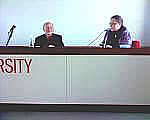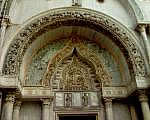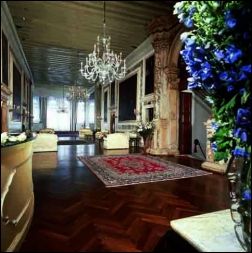|

|
Jean Clair lectured on "Art and the Pietà" and guided us to north facade of the San Marco basilica, to the sculptural image of the Nativity above the entrance to the Porta dei Fiori - the flower portal (*) and Gallery dell' Accademia for an excursion to deepen the fascinating mystery of the art by Titiaan and Bellini. After lunch, some time to go to the yearly La Biennale di Venezia and the basilica Santa Maria Gloriosa del FRARI. In cafe Florian, plaza San Marco in Venice, we coincidently met Jean Clair, while on the watertaxi to San Servolo George Steiner and Ingrid Rowland.
(*) The so-called Flower Portal was placed in front of the original entrance in the thirteenth century. 'The Lower Arch of Arab-moorish type, with the double curve, is decorated with carved bunches and figures of angels, framing the relief of the Nativity, which together with the rich decorations of volutes, intertwining branches and the figures op Prophets, constitutes another important Romanic sculptural work of the XIII century.' The door is crowned by a sixth archery with bas-reliefs in both intra-red and extradox, of high quality stylistic quality. Between a floral entanglement, eleven Prophets with half bust, plus two others that are placed on the base left and right, full figure, who are associated with eagles, griffons, lion dragons, and angels. In the intradox the top, center of the arc, ends with the magnificent Madonna, with the palms of the hands facing outside, between two angels whose arms, wings, and the twist of the faces meet harmoniously integrating with the external floral frame. Outside in the extradox, a strong young Christ Pantocrator, blessed between Saint Peter on his left and Saint Paul on his right. The curious thing is that the hand that makes the gesture is represented not by how you look at it from the outside but from the inside. The extraordinary restorations carried out have put great emphasis on the beauty of the sculptures, and their strong and intense expressive charge, the terribleness of men - apostles - with strength-filled faces, in God's grace. |











